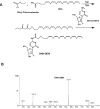The targeting mechanism of DHA ligand and its conjugate with Gemcitabine for the enhanced tumor therapy
- PMID: 25004114
- PMCID: PMC4116508
- DOI: 10.18632/oncotarget.1969
The targeting mechanism of DHA ligand and its conjugate with Gemcitabine for the enhanced tumor therapy
Abstract
Docosahexaenoic acid (DHA), an omega-3 C22 natural fatty acid serving as a precursor for metabolic and biochemical pathways, was reported as a targeting ligand of anticancer drugs. However, its tumor targeting ability and mechanism has not been claimed. Here we hypothesized that the uptake of DHA by tumor cells is related to the phosphatidylethanolamine (PE) contents in cell membranes. Thus, in this manuscript, the tumor-targeting ability of DHA was initially demonstrated in vitro and in vivo on different tumor cell lines by labeling DHA with fluorescence dyes. Subsequently, the tumor targeting ability was then correlated with the contents of PE in cell membranes to study the uptake mechanism. Further, DHA was conjugated with anticancer drug gemcitabine (DHA-GEM) for targeted tumor therapy. Our results demonstrated that DHA exhibited high tumor targeting ability and PE is the main mediator, which confirmed our hypothesis. The DHA-GEM displayed enhanced therapeutic efficacy than that of GEM itself, indicating that DHA is a promising ligand for tumor targeted therapy.
Figures







Similar articles
-
Hyaluronan-conjugated liposomes encapsulating gemcitabine for breast cancer stem cells.Int J Nanomedicine. 2016 Apr 5;11:1413-25. doi: 10.2147/IJN.S95850. eCollection 2016. Int J Nanomedicine. 2016. PMID: 27103799 Free PMC article.
-
Polyisoprenoyl gemcitabine conjugates self assemble as nanoparticles, useful for cancer therapy.Cancer Lett. 2013 Jul 1;334(2):346-53. doi: 10.1016/j.canlet.2012.08.023. Epub 2012 Aug 27. Cancer Lett. 2013. PMID: 22935679
-
Targeted delivery of a peripheral benzodiazepine receptor ligand-gemcitabine conjugate to brain tumors in a xenograft model.Cancer Chemother Pharmacol. 2001 Aug;48(2):169-76. doi: 10.1007/s002800100284. Cancer Chemother Pharmacol. 2001. PMID: 11561783
-
A conjugate of gemcitabine with bisphosphonate (Gem/BP) shows potential as a targeted bone-specific therapeutic agent in an animal model of human breast cancer bone metastases.Oncol Res. 2011;19(6):287-95. doi: 10.3727/096504011x13021877989874. Oncol Res. 2011. PMID: 21776824
-
Enhanced anticancer activity of gemcitabine coupling with conjugated linoleic acid against human breast cancer in vitro and in vivo.Eur J Pharm Biopharm. 2012 Oct;82(2):401-9. doi: 10.1016/j.ejpb.2012.06.007. Epub 2012 Jun 21. Eur J Pharm Biopharm. 2012. PMID: 22728546
Cited by
-
A Novel Dextran-Based Dual Drug Conjugate Targeted Tumors with High Biodistribution Ratio of Tumors to Normal Tissues.Int J Nanomedicine. 2022 Oct 17;17:4895-4910. doi: 10.2147/IJN.S379758. eCollection 2022. Int J Nanomedicine. 2022. PMID: 36262192 Free PMC article.
-
Omega-3 fatty acids, membrane remodeling and cancer prevention.Mol Aspects Med. 2018 Dec;64:79-91. doi: 10.1016/j.mam.2018.04.001. Epub 2018 Apr 12. Mol Aspects Med. 2018. PMID: 29627343 Free PMC article. Review.
-
Fatty acid traits mediate the effects of uric acid on cancers: a Mendelian randomization study.Front Genet. 2024 Dec 2;15:1449205. doi: 10.3389/fgene.2024.1449205. eCollection 2024. Front Genet. 2024. PMID: 39687737 Free PMC article.
-
Tumor targeting with docosahexaenoic acid-conjugated docetaxel for inhibiting lung cancer metastasis to bone.Oncol Lett. 2018 Sep;16(3):2911-2920. doi: 10.3892/ol.2018.9047. Epub 2018 Jun 28. Oncol Lett. 2018. PMID: 30127879 Free PMC article.
-
Neuroprotective Effect of ω-3 Polyunsaturated Fatty Acids on Bilirubin Encephalopathy In Vitro and In Vivo.Med Sci Monit. 2018 Apr 28;24:2631-2638. doi: 10.12659/MSM.907131. Med Sci Monit. 2018. PMID: 29704452 Free PMC article.
References
-
- Jaracz S, Chen J, Kuznetsova LV, Ojima I. Recent advances in tumor-targeting anticancer drug conjugates. Bioorg Med Chem. 2005;13:5043–54. - PubMed
-
- Dicheva BM, Koning GA. Targeted thermosensitive liposomes: an attractive novel approach for increased drug delivery to solid tumors. Expert Opin Drug Deliv. 2014;11:83–100. - PubMed
-
- Yang Y, Zhang X, Yu C, Hao X, Jie J, Zhou M, Zhang X. Smart Nanorods for Highly Effective Cancer Theranostic Applications. Adv Healthc Mater. 2013;27 - PubMed
-
- Forero-Torres A1, Infante JR, Waterhouse D, Wong L, Vickers S, Arrowsmith E, He AR, Hart L, Trent D, Wade J, Jin X, Wang Q, Austin T, Rosen M, Beckman R, von Roemeling R et al. Phase 2, multicenter, open-label study of tigatuzumab (CS-1008), a humanized monoclonal antibody targeting death receptor 5, in combination with gemcitabine in chemotherapy-naive patients with unresectable or metastatic pancreatic cancer. Cancer Med. 2013;2:925–32. - PMC - PubMed
Publication types
MeSH terms
Substances
Grants and funding
LinkOut - more resources
Full Text Sources
Other Literature Sources
Research Materials

